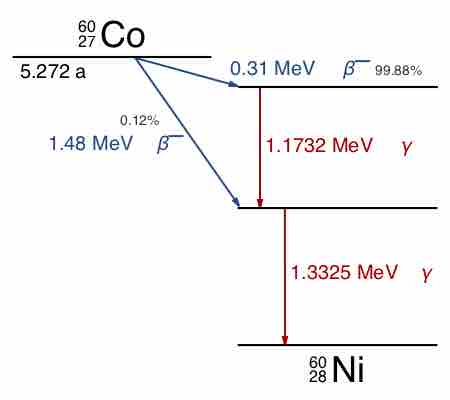Most of the questions are answered in the linked wikipedia article, particularly the ambiguities of the current nomenclature, so I'm not going to restate what it says there, and it is fairly complete.
Looking at the cobalt-60 decay energy diagram:

You see there are two channels. Each is beta decay is to a nickel-60 isomer. The $^{60m1}{\rm Ni}$, $^{60m2}{\rm Ni}$ then decay via the electromagnetic interaction ($\gamma$ ray) to the stable ground state, $^{60}{\rm Ni}$
Since energy is released, the mass of $^{60}{\rm Ni}$ ($M=55825.174085\,$MeV) is less than that of $^{60m}{\rm Ni}$ by the energy of the gamma ray.
So looking the two isomers:
$$M_1 = M + 1.3325\,{\rm MeV}=55826.50658499274\,{\rm MeV}$$
$$M_2 = M + 2.5057\,{\rm MeV}=55827.679784992746\,{\rm MeV}$$
While the masses of constituent nucleons is:
$$m_pZ + (A-Z)m_n=56337.711500405436\,{\rm MeV}>M_2$$
The binding energy is the difference, so for Nickel and the 1st isomer:
$$ B_0/A = 8.542290256878186\,{\rm MeV/nucleon}$$
$$ B_1/A = 8.520081923544906\,{\rm MeV/nucleon}$$
$$ B_2/A = 8.500528590211495\,{\rm MeV/nucleon}$$
Thus: the isomer has less binding energy (larger mass) than the ground state. At greater excitation energy, the binding energy falls. When it passes 0 and becomes negative: the nucleons have too much energy and the nucleus is totally unbound. (Of course, in practice, this may happen sooner...by emitting a $\alpha$ particle, for instance, in which case a new nucleus can be formed).
In this decay, $^{60}\rm Ni$ is spin-0, so it is a spherically symmetric charge distribution. The 1st isomer is not, it has an electric quadrupole moment. The two states are coupled by the electric quadrupole operator via the emission of a gamma ray.
Regarding how an isomer is formed: protons and neutrons are more then fungible, even more than identical, they are indistinguishable. Indistinguishability is a deeply quantum mechanical concept. Moreover, in the context of the strong nuclear force, protons and neutrons are indistinguishable, so you cannot label which proton or neutron is excited. You cannot always declare if a nucleon is a proton or a neutron.
For instance, the $^3{\rm He}$ wave function could look like:
$$\Psi(N_1,N_2,N_3) = \psi_{space}(\vec r_1, \vec r_2, \vec r_3) \times \chi_{spin}\times \tau_{isospin} $$
where it has been factored into a spatial component ($\psi$), a spin component ($\chi$), and an isospin component ($\tau$). Here, the proton (neutron) are the $\tau_3 =\pm \frac 1 2$ isospin eigenstates of the $\tau=\frac 1 2$ nucleon, labeled $|p\rangle$ ($|n\rangle$).
A ultra simplified toy model is:
$$\Psi(N_1,N_2,N_3)=[S(\vec r_1)S(\vec r_2)S(\vec r_3)] \times |\uparrow\uparrow\uparrow\rangle \times\frac 1{\sqrt 6}(|ppn\rangle+|pnp\rangle-2|npp\rangle)$$
Here $S(\vec r_i)$ refers to the $i^{th}$ nucleon being in a $l=0$ S-state. (It's a toy model because it has the wrong spin and the wrong symmetry, but it's purpose is to show just how "fungible" nucleons are).
The spin wave function has all 3 nucleons spin-up (again, toy model), and the isospin wave function shows that the nucleons aren't in definite isospin states. The 1st nucleon, for instance, is $1/3$ proton and $2/3$ neutron.
An isomer could put a nucleon into an excited orbit state, say and $l=1$ $P$-state, thereby changing the shape of the nucleus. The spatial wave function would then be:
$$\psi^*_{space}(\vec r_1, \vec r_2, \vec r_3)=
\frac 1 {\sqrt 3}[P(\vec r_1)S(\vec r_2)S(\vec r_3)+S(\vec r_1)P(\vec r_2)S(\vec r_3)+S(\vec r_1)S(\vec r_2)P(\vec r_3)
]
$$
and the full wave function:
$$\Psi^*(N_1,N_2,N_3)=\frac 1 {\sqrt 3}[P(\vec r_1)S(\vec r_2)S(\vec r_3)+S(\vec r_1)P(\vec r_2)S(\vec r_3)+S(\vec r_1)S(\vec r_2)P(\vec r_3)
] \times |\uparrow\uparrow\uparrow\rangle \times\frac 1{\sqrt 6}(|ppn\rangle+|pnp\rangle-2|npp\rangle)$$
You can put this in sympy and multiply it out. Individual terms look like:
$$ \frac 1 {\sqrt{18}} P(\vec r_1)S(\vec r_2)S(\vec r_3)|\uparrow\uparrow\uparrow\rangle|ppn\rangle$$
which means the 1st nucleon is $1/18^{th}$ a spin up, orbitally excited proton (along with another similar term). Other terms are an unexcited proton or neutron, or an excited neutron (all spin up, for simplicity of the toy model)..and each with different entangled states with the other nucleons.
And that was a static quantum mechanical shell toy model. IRL one has to consider (effective) field theory states with virtual exchange mesons and all that stuff. The point being: and excited state (isomer) is a unique state of entangled nucleons, and you cannot label which nucleon is excited. (BTW: the same principle applies to atomic physics. For instance, we'll say in X-ray absorption, that a K-shell electron is kicked out of an Fe atom, but that electron was an entangled mixture of all 26 atomic electrons, so the language we use is sometimes misleading...e.g., too classical).